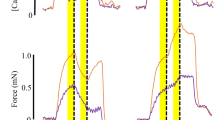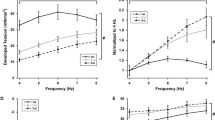Abstract
β-Adrenergic agonists increase tension production in fast-twitch skeletal muscle, but the underlying mechanism is unknown. In the present study we have exposed intact, single fibres from a mouse muscle to the β 2-adrenergic agonist terbutaline. Fibres were stimulated to produce 350-ms tetani at 20–100 Hz while measuring the myoplasmic Ca2+ concentration ([Ca2+]i) and tension. The fluorescent indicator Indo-1 was used to measure [Ca2+]i. Application of terbutaline resulted in marked increases of both tetanic [Ca2+]i and tension. Terbutaline had no significant effect on myofibrillar function as judged from normal Ca2+ sensitivity and tension production at saturating [Ca2+]i. The rate of [Ca2+]i and tension decline during relaxation was not affected by terbutaline, thus indicating a normal function of the sarcoplasmic reticulum (SR) Ca2+ pumps. The effect of terbutaline developed gradually over 5–10 min when fibres were stimulated each minute; the full effect of terbutaline was also obtained after a 10-min rest period in terbutaline. The [Ca2+]i at rest was not affected by terbutaline. In conclusion, β-adrenergic stimulation increases tetanic tension by enhancing SR Ca2+ release.
Similar content being viewed by others
References
Arreola J, Calvo J, Garcia C, Sánchez JA (1987) Modulation of calcium channels of twitch skeletal muscle fibres of the frog by adrenaline and cyclic adenosine monophosphate. J Physiol (Lond) 393: 307–330
Bowman WC, Raper C (1964) The effect of adrenaline and other drugs affecting carbohydrate metabolism on contraction of the rat diaphragm. Br J Pharmacol Chemother 23: 184–200
Brown GL, Bülbring E, Burn BD (1948) The action of adrenaline on mammalian skeletal muscle. J Physiol (Lond) 107: 115–128
Brum G, Gonzalez S, Ferreira G, Maggi M, Santi C (1990) Effects of adrenaline on calcium release in single fibres of frog skeletal muscle (abstract). Biophys J 57: 342 a
Cairns SP, Westerblad H, Allen DG (1992) Changes of myoplasmic calcium concentration during β-adrenoceptor activation in single skeletal muscle fibres from the mouse (abstract). Proc Aust Physiol Pharmacol Soc 23:64 P
Callewaert G, Cleemann L, Morad M (1988) Epinephrine enhances Ca2+ current-regulated Ca2+ release and Ca2+ reuptake in rat ventricular myocytes. Proc Natl Acad Sci USA 85: 2009–2013
Challis RAJ, Lozeman FJ, Leighton B, Newsholme EA (1986) Effects of the β-adrenoceptor agonist isoprenaline on insulinsensitivity in soleus muscle of the rat. Biochem J 233: 377–381
Clausen T, Flatman JA (1977) The effect of catecholamines on Na-K transport and membrane potential in rat soleus muscle. J Physiol (Lond) 270: 383–414
Curtis BM, Catterall WA (1985) Phosphorylation of the calcium antagonist receptor of the voltage-sensitive calcium channel by cAMP-dependent protein kinase. Proc Natl Acad Sci USA 82: 2528–2532
England PJ, Pask HT, Mills D (1984) Cyclic-AMP-dependent phosphorylation of cardiac contractile proteins. Adv Cyclic Nucleotide Protein Phosphorylation Res 17: 383–390
Fabiato A, Fabiato A (1978) Cyclic AMP-induced enhancement of calcium accumulation by the sarcoplasmic reticulum with no modification of the sensitivity of the myofilaments to calcium in skinned fibres from a fast skeletal muscle. Biochim Biophys Acta 539: 253–260
Garcia J, Gamboa-Aldeco R, Stefani E (1990) Charge movement and calcium currents in skeletal muscle fibers are enhanced by GTPγS. Pflügers Arch 417: 114–116
Gillis JM (1985) Relaxation of vertebrate skeletal muscle. A synthesis of the biochemical and physiological approaches. Biochim Biophys Acta 811: 97–145
Godt RE, Nosek TM (1989) Change of intracellular milieu with fatigue or hypoxia depress contraction of skinned rabbit skeletal and cardiac muscle. J Physiol (Lond) 412: 155–180
Hymel L, Schindler H, Yang S-D, Inui M, Reif S, Fleischer S (1989) Protein kinase/phosphatase modulation of purified skeletal muscle calcium release channel activity in planar bilayers (abstract). Biophys J 55: 307 a
Jorgensen AO, Jones LR (1986) Localization of phospholamban in slow but not fast canine skeletal muscle fibers. J Biol Chem 261: 3775–3781
Lamb GD (1992) DHP receptors and excitation-contraction coupling. J Musc Res Cell Motil 13: 394–405
Lamb GD, Walsh T (1987) Calcium currents, charge movement and dihydropyridine binding in fast- and slow-twitch muscles of rat and rabbit. J Physiol (Lond) 595: 617
Lännergren J, Westerblad H (1991) Force decline due to fatigue and intracellular acidification in isolated fibres from mouse skeletal muscle. J Physiol (Lond) 434: 307–322
Millar NC, Homsher E (1990) The effect of phosphate and calcium on force generation in glycerinated rabbit skeletal muscle fibers. J Biol Chem 265: 20 234–20 240
Oota I, Nagai T (1977) Effects of catecholamines on excitation-contraction coupling in frog single twitch fiber. Jpn J Physiol 27: 195–213
Rios E, Pizarro G (1991) Voltage sensor of excitation-contraction coupling in skeletal muscle. Physiol Rev 71: 849–908
Salviati S, Sorenson MM, Eastwood AB (1982) Calcium accumulation by the sarcoplasmic reticulum in two populations of chemically skinned human muscle fibers. Effects of calcium and cyclic AMP. J Gen Physiol 79: 603–632
Seiler S, Wegener AD, Whang DD, Hathaway DR, Jones LR (1984) High molecular weight proteins in cardiac and skeletal muscle junctional sarcoplasmic reticulum vesicles bind calmodulin, are phosphorylated, and are degraded by Ca2+-activated protease. J Biol Chem 259: 8550–8557
Stull JT, Blumenthal DK, Cooke R (1980) Regulation of contraction by myosin phosphorylation. A comparison between smooth and skeletal muscles. Biochem Pharmacol 29: 2537–2543
Tada M, Kadoma M, Inui M, Fujii J (1988) Regulation of Ca2+-pump from cardiac sarcoplasmic reticulum. Methods Enzymol 157: 107–154
Takasago T, Imagawa T, Shigekawa M (1989) Phosphorylation of the cardiac ryanodine receptor by cAMP-dependent protein kinase. J Biochem 106: 872–877
Timerman AP, Chadwick CC, Fleischer S (1990) Phosphorylation states of skeletal muscle ryanodine receptor and smooth muscle inositol 1,4,5-triphosphate receptor (IP3Rec) (abstract). Biophys J 57: 286 a
Turner PR, Westwood T, Regen CM, Steinhardt RA (1988) Increased protein degradation results from elevated free calcium levels found in the muscle from mdx mice. Nature 335: 735–738
Westerblad H, Allen DG (1991) Changes of myoplasmic calcium concentration during fatigue in single mouse muscle fibers. J Gen Physiol 98: 615–635
Westerblad H, Allen DG (1992) Changes of intracellular pH due to repetitive stimulation of single fibres from mouse skeletal muscle. J Physiol (Lond) 449: 49–71
Westerblad H, Allen DG (1992) Effects of 2,5-di-(tert-butyl)-1,4-benzohydroquinone on the intracellular calcium and tension from isolated mouse skeletal muscle fibres (abstract). Proc Aust Physiol Pharmacol Soc 23:63 P
Westerblad H, Allen DG (1993) The influence of intracellular pH on contraction, relaxation and [Ca2+]i in intact single fibres from mouse muscle. J Physiol (Lond) 466: 611–628
Williams JH, Barnes WS (1989) The positive inotropic effect of epinephrine on skeletal muscle: a brief review. Muscle Nerve 12: 968–975
Witcher DR, Kovacs RJ, Schulman H, Cefali DC, Jones LR (1991) Unique phosphorylation site on the cardiac ryanodine receptor regulates calcium channel activity. J Biol Chem 266: 11 144–11 152
Author information
Authors and Affiliations
Rights and permissions
About this article
Cite this article
Cairns, S.P., Westerblad, H. & Allen, D.G. Changes of tension and [Ca2+]i during β-adrenoceptor activation of single, intact fibres from mouse skeletal muscle. Pflugers Arch. 425, 150–155 (1993). https://doi.org/10.1007/BF00374515
Received:
Revised:
Accepted:
Issue Date:
DOI: https://doi.org/10.1007/BF00374515




